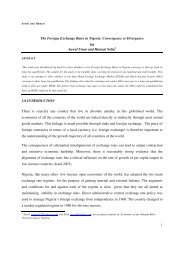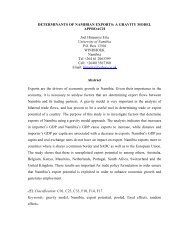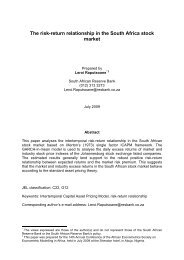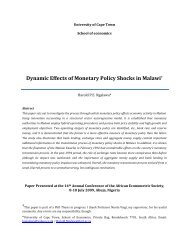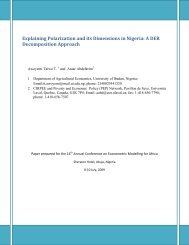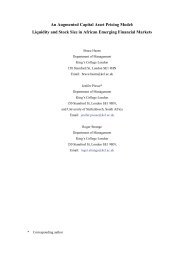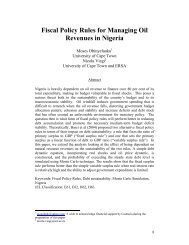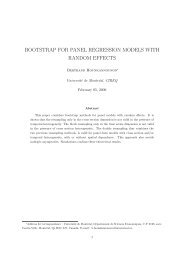Local government revenues and expenditures in Uganda: A VAR ...
Local government revenues and expenditures in Uganda: A VAR ...
Local government revenues and expenditures in Uganda: A VAR ...
You also want an ePaper? Increase the reach of your titles
YUMPU automatically turns print PDFs into web optimized ePapers that Google loves.
{ G t} be affected by the current <strong>and</strong> past realizations of the { t}T sequence <strong>and</strong> the let thetime path of the { T t} sequence be affected by current <strong>and</strong> past realizations of the{ G t} sequence. Our simple bivariate system can be represented as a first order <strong>VAR</strong>3 asfollows:[1]G = bt10+ b12Tt+ γ G11t−1+ γ T12t−1+ εGt[2]T = bt20+ b21Gt+ γ G21t−1+ γ T22t−1+ εTtWhere (as verifed above), both G <strong>and</strong> are stationary <strong>and</strong> thetT { ε } <strong>and</strong> { ε }tuncorrelated white noise disturbances. Here, is the contemporaneous effect of a unitchange of T on <strong>and</strong> γ the effect of a unit change <strong>in</strong> G on T . In other words, thetGt21structure of this system <strong>in</strong>corporates feedback s<strong>in</strong>ce Gt<strong>and</strong> Ttare allowed to affect eachother. After some manipulation, the above structural <strong>VAR</strong> (equations [1] <strong>and</strong> [2]) can bereduced to follow<strong>in</strong>g st<strong>and</strong>ard form:b 12t−1tGtTtare[3]G = at10+ a11Gt−1+ a12Tt−1+ e1t[4]T = at20+ a21Gt−1+ a22Tt−1+ e2tS<strong>in</strong>ce equations [3] <strong>and</strong> [4] each have identical right-h<strong>and</strong>-side variables, estimation viaord<strong>in</strong>ary least squares technique will yield efficient estimates. Table 3 shows results fromthe <strong>VAR</strong> estimation <strong>and</strong> were obta<strong>in</strong>ed with one lag for each variable. The results <strong>in</strong>Table 3 confirm the uni-directional causation between <strong>expenditures</strong> <strong>and</strong> <strong>revenues</strong> withcausation runn<strong>in</strong>g from <strong>government</strong> <strong>revenues</strong> to <strong>government</strong> <strong>expenditures</strong>. In otherwords, local <strong>government</strong> <strong>revenues</strong> <strong>and</strong> <strong>expenditures</strong> are related by a feedback causalmechanism, <strong>and</strong> this is consistent with the tax-spend hypothesis <strong>in</strong>dicat<strong>in</strong>g that the local<strong>government</strong>s <strong>in</strong> Ug<strong>and</strong>a raise <strong>revenues</strong> first <strong>and</strong> then identify spend<strong>in</strong>g priorities.Table 3. <strong>VAR</strong> estimation results: 2001-2003Equationln <strong>revenues</strong> ln <strong>expenditures</strong>ln <strong>revenues</strong> 0.636(6.77)***0.067(1.68)*ln <strong>expenditures</strong> -0.077(0.36)0.505(5.54)***Constant 9.292 9.7272Adj. R 0.37 0.40Durb<strong>in</strong>-Watson 1.83 1.943 The optimal lag length was determ<strong>in</strong>ed us<strong>in</strong>g the Schwarz BIC model selection criterion.5



